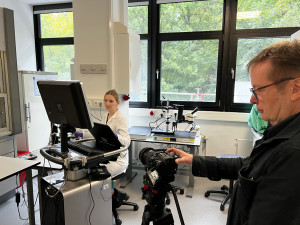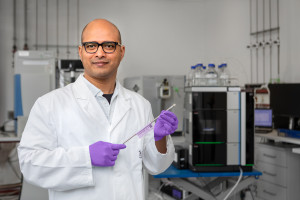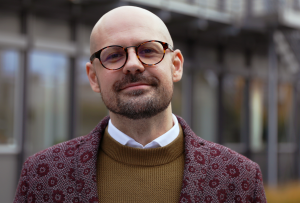Dortmund, 5th July 2024
The butterfly-shaped thyroid gland is located below the larynx and produces hormones that affect tissues and organs throughout the body – especially the heart. Having a thyroid that is even slightly overactive or underactive can increase the risk of vascular disease and mortality by 20 to 80 percent1. ISAS researchers investigated how thyroid hormones affect heart tissue and which control mechanisms they are subject to in the heart. As part of the Collaborative Research Centre (CRC) "Local Control of Thyroid Hormone Action – LOCOTACT", they want to work together with other scientists to answer the question: how does the body control the transport, metabolism and mode of action of thyroid hormones in the heart? Their aim is to find new treatment approaches to cardiovascular diseases, for example.
A focus on local control mechanisms
Even a slight excess or deficiency of the thyroid hormones triiodothyronine (T3) and thyroxine (tetraiodothyronine, T4) can change a person's heart rate and blood pressure, for instance. This could lead to cardiovascular conditions including arrhythmia, atherosclerosis (hardening of the arteries) and heart failure. Only in recent years has the world of medicine realised that it is not enough to simply test how much T3 and T4 is released into the blood throughout the body when diagnosing thyroid conditions. That's because this systemic value has little to do with the specific level of thyroid hormones in organs such as the liver, brain and heart. Receptors and transport molecules in these organs affect the quantity of thyroid hormones transported into and out of single cells – and how they act on the functions of the relevant organ cells. Understanding how this process occurs or how it is disrupted can help to prevent stroke, cardiac insufficiency (heart failure) or hepatopathy (liver disease), for example, or to treat these conditions in a more targeted way than before.
CRC LOCOTACT is interested in this local control of thyroid hormones. Led by University Hospital Essen (UK Essen) – and funded by 13.7 million euros from the German Research Foundation – the researchers form an interdisciplinary team hailing from the University of Lübeck, Charité – Universitätsmedizin Berlin, the Helmholtz Zentrum Munich, Leipzig University and ISAS.

The photo shows Stefanie Dörr, PhD student in the ISAS research group Cardiovascular Pharmacology, in one of the laboratories at Essen University Hospital. Videographer André Zelck, on the right, accompanied several doctoral students from the CRC "Local Control of Thyroid Hormone Action - LOCOTACT" in October 2023. The video was intended to give the reviewers from the German Research Foundation (DFG) a clear picture of the research. When this photo was taken, Dörr was examining the heart of a mouse with an ultrasound machine.
© ISAS
Which receptor makes the heart "beat faster"?
In 2023 a team of LOCOTACT researchers, including Prof Dr med. Lars C. Möller (UK Essen) and Prof Dr Kristina Lorenz (Head of the Cardiovascular Pharmacology research group at ISAS), investigated which of the two thyroid hormone receptors TRα and TRβ controls the heart rate and can potentially cause the heart muscle to thicken. They were primarily interested in understanding the fundamental processes involved. On the one hand, thyroid hormones can act directly on the genome of the heart muscle cells by means of receptor binding, i.e. they can alter the gene expression. And on the other, they can also act non-genomically: in the ion channels of the cell membrane, for example.
The researchers studied the effect of treating genetically modified mice, which were missing one of these two receptors (TRα or TRβ), with T3. There was a control group made up of mice that were not genetically modified and that had both receptors. The researchers were able to determine from the animals' different responses to the T3 treatment that the receptor TRα mainly regulates the heart rate in mice – and it does so by acting on the genome. Indirectly, or non-genomically, TRα can also cause the cardiac chambers to enlarge. TRβ plays only a supporting role in this, although it does also have an effect on heart rate. The researchers have published their results on bioRxiv as a pre-print (pre-release of a scientific paper that has not yet been peer reviewed) in 2023. The following year, their results were also published in the journal Thyroid.
Article Recommendation
Geist, D., Hönes, G.S., Grund, S.C., Pape, J., Siemes, D., Spangenberg, P., Tolstik, E., Dörr, S., Spielmann, N., Fuchs, H., Gailus-Durner, V., Hrabe de Angelis, M., Mittag, J., Engel, D.R., Führer, D., Lorenz, K., Moeller, L.C.
(2024) Canonical and noncanonical contribution of thyroid hormone receptor isoforms alpha and beta to cardiac hypertrophy and heart rate in male mice. Thyroid. https://doi.org/10.1089/thy.2023.0683.
Rare genetic defect provides an insight into how heart rate is controlled
One series of investigations had a surprising result for the researchers working with Prof Dr Jens Mittag (University of Lübeck). The starting point for this study were three patients in whom the TRα receptor was not completely absent, but a genetic defect meant the receptor responded to thyroid hormones less sensitively than in healthy individuals. The inherited defect RTHα – which affects one in 40,000 newborns worldwide2 – causes hypothyroidism in some tissues even when blood levels are normal.
This can lead to growth retardation and other developmental disorders. In theory, the defect can be balanced out by giving the patient extra thyroid hormones (T3). However, since the receptor concerned, TRα, regulates the heart rate, there is some concern that this could give rise to tachycardia (palpitations). Contrary to expectations, this effect was not observed in the three patients. This led the researchers to conduct further studies on mice, which indicate that RTHα affects not only the receptor itself: the genetic defect also causes specific genes in the heart tissue to be less active than in healthy individuals.
It is particularly interesting to note that this not only affects genes that were already known to control heart rate (specifically, genes that play a part in potassium and calcium flow in heart tissue), but also genes that previously had no known link to this process. The study, published in the journal Nature Communications, therefore suggests that thyroid hormones affect the heart in a way that is more complex than previously thought. But it also means that RTHα patients can be given hormone treatment without the risk of tachycardia.
Article Recommendation
Dore, R., Watson, L., Hollidge, S., Krause, C., Sentis, S. C., Oelkrug, R., Geißler, C., Johann, K., Pedaran, M., Lyons, G., Lopez-Alcantara, N., Resch, J., Sayk, F., Iwen, K. A., Franke, A., Boysen, T. J., Dalley, J. W., Lorenz, K., Moran, C., Rennie, K. L., Arner, A., Kirchner, H., Chatterjee, K., Mittag, J.
Resistance to thyroid hormone induced tachycardia in RTHα syndrome.
(2023) Nature Communications 14, 3312 (2023). https://doi.org/10.1038/s41467-023-38960-1.
The response to thyroid hormones: A question of age?
Lorenz's team in Dortmund, together with other researchers working with Prof Dr Führer-Sakel (UK Essen), demonstrated the variety of ways in which thyroid hormones act on the heart in a publication in the journal Frontiers in Endocrinology. Their investigation focused on identifying the possible consequences of giving thyroid hormones to patients with heart conditions.
The researchers added T4 to the drinking water of 12-month-old mice in the initial stages of heart failure. They observed that administering the hormone to the animals had no effect whatsoever on cardiac function. This was surprising, as a previous study published by the team looking at eight-week-old mice had shown low doses of T4 improved cardiac function (whereas high doses led to further deterioration). The results indicate that local control of thyroid hormones in the heart tissue changes over a lifetime. If this is also confirmed in humans, it could mean that elderly hearts – which are at elevated risk of cardiac diseases – respond to thyroid hormones less directly.
Article Recommendation
Kerp, H., Gassen, J., Grund, SC., Hönes, GS., Dörr, S., Mittag, J., Härting, N., Kaiser, F., Moeller, LC., Lorenz, K.*, and Führer, D.* (2024) Cardiac recovery from pressure overload is not altered by thyroid hormone status in old mice. Frontiers in Endocrinology 15:1339741. https://doi.org/10.3389/fendo.2024.1339741.
(* Korrespondierende Autorinnen)
Funded by Deutsche Forschungsgemeinschaft (DFG) – project number 424957847-TRR 296.
1https://www.intechopen.com/chapters/85639
2https://www.ncbi.nlm.nih.gov/pmc/articles/PMC4790576/#:~:text=T...impaired%20sensitivity,on%20the%20thyroid%20hormone%20receptor
(Ute Eberle)








